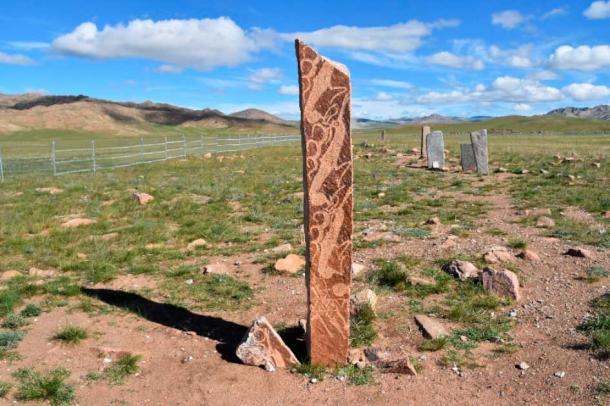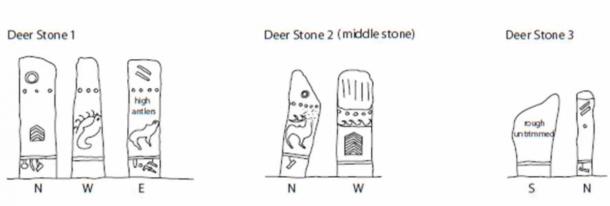
The Mysterious Deer Stones of Mongolia
Mongolia is steeped in rich, ancient culture. One of the most fascinating discoveries made in Mongolia is that of their mysterious deer stones. These deer stones are estimated to be at least 2,700 years old and depict several images, including deer, elk, horses, human faces, and the sun. These Bronze Age masterpieces are fascinating, as they provide some insight into the people that lived at the time of their creation, but otherwise provide little to no detail about their purpose. To this day, archaeologists continue to dig deeper to discover more about the deer stones and the people who created them.
- Spectacular photographs shed light on the ancient nomadic lifestyle of Mongolia
- Monumental Mongolian Burial Discovered Includes 14 Giant Inscribed Pillars

A Mongolian deer stone, with yurt in background (lamoix / CC BY 2.0)
A Centuries Old Mystery
The first deer stone analysis was concluded over a hundred years ago. In 1856, D. P. Daydoff discovered the Ivolga Stone in modern-day Ulan-Ude, Russia, and published an article about the rare deer stone. Just a few decades later, in 1892, V. V. Radlov, a Russian Turkologist specializing in Turkic languages, published several drawings of other deer stones he had found throughout Mongolia. These researchers found the monoliths fascinating, but could only theorize their purpose.
A study in the late 20th century by V. V. Volkov theorized that the eastern deer stones were likely connected to the slab grave culture of the Bronze Age. He also posited that some of the deer stones were involved in ancient rituals, as several have been found positioned in giant circles facing specific directions. This theory was later supported by the discovery of animal bones around and underneath several of the discovered deer stones.
Although some historians speculated that the deer stones were actually ancient gravestones, none of the stones were found to have human remains around or underneath them. Instead, some have proposed that the stones were carved to honor or represent deceased individuals. This would make sense, as many of the stones depict warriors and weapons, and they are completely unique from one another. One warrior’s deer stone would be different from another’s, as they had completely different lives and histories.
While the exact purpose behind the deer stones has not yet been discovered, historians are certainly interested in analyzing their potential meaning. Today, at least 1,500 deer stones have been discovered throughout Mongolia. Researchers working on these stones hope that further discoveries will uncover more information about the stones and the people that created them. To assist with this process, the Smithsonian Institution started the Deer Stone Project in 2006, which began to store the stones digitally using 3D scanning. Easier comparison of these stones could lead to further conclusions in the future.
- Study Unravels the Mysterious Origins of Nomadic Mongolian Empires
- Discovered! An Ancient Mongolian Stone Selfie!

Bronze Age deer stone site, near Moron, northern Mongolia (Richard Mortel / CC BY 2.0)
Deer Stones: From Animals to Weapons
Deer stones were mostly carved out of granite or greenstone, depending on the region they were made in. Although each deer stone is similar in composition, they vary greatly in height, with some being as short as 3 feet and others being as tall as 15 feet (0.9 to 4.5 meters tall). Typically, they vary between 11 to 31 inches (28 to 78 centimeters) in width and 7 to 16 inches (17 to 40 centimeters) in thickness.
There seems to be no rhyme or reason for the shapes of the stones; some have round tops while others have flat tops. In addition to these shapes, some of the deer stones have tops that are broken off, leaving their original shape unclear. Archaeologists are currently unsure whether these broken tablets once had portions of greater significance along their tops. Because of the type of destruction found on some of the deer stones, it is believed that some were intentionally damaged along the top for a currently unknown reason.

The deer stones of Mongolia have been found with different shapes and orientation (Kyarrakun / CC BY SA 3.0)
Most of the deer stones discovered so far have been found standing with their decorated sides facing the east. The carved portions were primarily done before the stones were erected, though some show clearer evidence of carving after they were already erected. Analysis of the stones indicates that the creators carved images into the stone using pecking or grinding methods. Further analysis determined that these carvings were done by hand using metal tools. Archaeologists have also theorized that some of the deer stones with unique patterns may have been carved using a unique tool, such as a primitive drill.
The majority of the subjects depicted on these stones include reindeer, elk, horses, cows, pigs, tigers, frogs, and birds. Flying reindeer are the most common carvings, lending the ancient monoliths the name ‘deer stones.’ It is believed that these flying reindeer represented protection, transformation, and transition, as they were often depicted alongside warriors or in relation to the sun. Some historians believe that reindeer may have been seen as guides to take the souls of the deceased to heaven, which would also explain their depiction as flying and being close to the sun.
Other objects seen among the carvings include weapons, tools, specific shape patterns, and human faces, though the last is the rarest. The human faces found on some of the stones have all been carved at the top of the stones and depict open mouths, suggesting they may have been part of a shamanistic ritual.
Three Types of Mystery
Archaeologists have determined that there are at least three distinct types of deer stones throughout Mongolia: classic Mongolian, western Asian-European, and Sayan-Altai. The classic Mongolian stones are described as detailed and elegant compared to the other two types. They typically depict images of belted warriors and flying red deer. They are typically found throughout northern Mongolia and southern Siberia.
West Asian-European deer stones depict unique shapes compared to the other two. They typically have large circles, ‘earring hoops,’ and necklaces engraved on them, as well as horizontal and diagonal divider lines. They may also have a collection of stone pits around them. Sayan-Altai deer stones are like a combination of classic Mongolian and western Asian-European. They are simple in design, but still contain more images than western Asian-European deer stones, including stick-like warriors, tools, and reindeer.

Depictions of the classic Mongolian, West Asian-European, and Sayan Altai styles of deer stone. (all Kyarrakun / CC BY SA 3.0)
Missing Pieces of the Puzzle
Although historians don’t have a full picture regarding the origin, purpose, or creators of the deer stones of Mongolia, they are an essential part of the puzzle. In the future, archaeologists will continue to uncover more deer stones, in hopes that some will provide further clarity about their purpose or the civilization that created so many of them. If you ever find yourself in Mongolia, be sure to check out these fascinating ancient masterpieces for yourself.
Top image: The Uushgiin Ovor deer stone site near Mörönь, Khovsgol, Mongolia. Source: Aloxe / Free Art Libre
By Lex Leigh
References
Deer Stone Monuments, the heart of Bronze Age culture. UNESCO World Heritage Center. December 19, 2014. Available at: https://whc.unesco.org/en/tentativelists/5953/
Fitzhugh, W. W. 2009. Stone Shamans and Flying Deer of Northern Mongolia: Deer Goddess of Siberia or Chimera of the Steppe? Arctic Anthropology, 46(1/2), 72–88. http://www.jstor.org/stable/40645464
Hays, J. February 2019. Deer Stones. Facts and Details. Available at: https://factsanddetails.com/asian/cat65/sub422/entry-5238.html
The Mongolian-Smithsonian deer stone project (DSP). Smithsonian Office of International Relations and Global Programs. (n.d.). Available at: https://global.si.edu/projects/mongolian-smithsonian-deer-stone-project-dsp
The Mysterious Deer Stones in Mongolia. Horseback Mongolia. November 16, 2019. Available at: https://www.mongolia-trips.com/deer-stones
Patowary, K. April 30, 2014. The Deer Stones of Mongolia. Amusing Planet. Available at: https://www.amusingplanet.com/2014/04/the-deer-stones-of-mongolia.html















Comments
So nobody has looked into from where the stones were quarried? Logic says they were used to hold up a heavy timber roof, not unlike Stonehenge, and almost certainly pre-Ice Age, when the climate and flora/fauna were much different. Of course, the silly diversions (religious ritual non-sense), and deceptive dating, have come to be expected from the dubious industry.
Nobody gets paid to tell the truth.